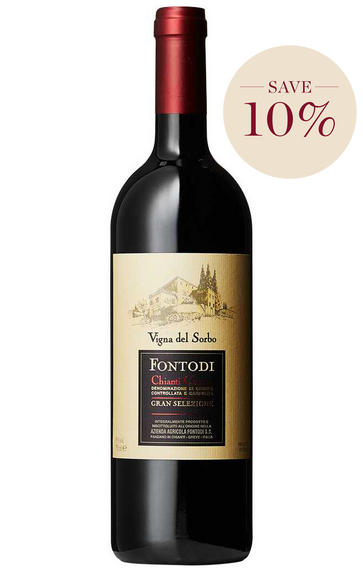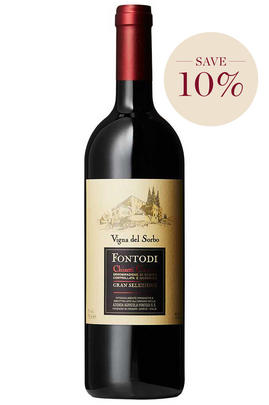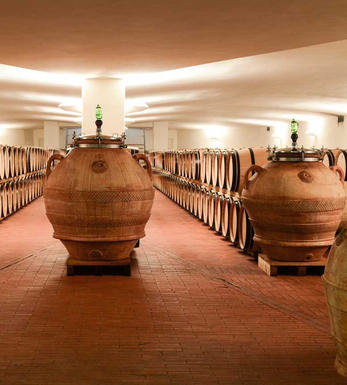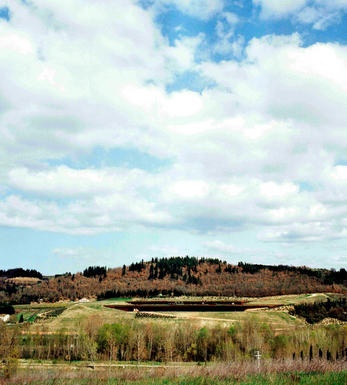
2019 Chianti Classico, Vigna del Sorbo, Gran Selezione, Fontodi, Tuscany, Italy

Critics reviews
The price of the 75cl bottle, reduced from £69.50 previously, includes a 10% discount. This offer does not apply to BBX listings.
The 2019 Chianti Classico Gran Selezione Vigna del Sorbo is a potent, virile wine endowed with tremendous depth and equally imposing tannins—a blast of dark fruit, herbs, chocolate, menthol and spice races out of the glass. Large-scaled tannins and hints of rusticity suggest that 2019 won’t be one of the most finessed Sorbos, but it is a fine effort for the year.
Drink 2025 - 2044
Antonio Galloni, Vinous.com (June 2022)
Panzano. 100% Sangiovese. Certified organic.
Mid to deep ruby. Savoury, minerally, elegant and a little understated on the nose. Deep succulent cherry fruit supported by the right dose of chewy tannins. Very long. It is concentrated, tangy and composed all at the same time.
Drink 2022 - 2032
Walter Speller, JancisRobinson.com (May 2022)
Complex aromas of dried flowers, orange peel, white pepper, and many cherries. Full-bodied but linear and very fine in the centre palate, with a linear flow of citrusy acidity. From organically grown grapes.
This will age beautifully, but it’s already impressive to taste.
James Suckling, JamesSuckling.com (August 2022)
At an elevation of 400 metres, Vigna del Sorbo boasts Chianti Classico’s classic Galestro soil. The warm southwest-facing vineyard typically yields a powerful, intense wine that needs ageing. The 2019 demonstrates this site’s wild, penetrating characteristics but becomes harmonious quickly, revealing its balance and precision.
Wood-driven top notes of smoke and vanilla meld into pressed violets, rosemary and liquorice. Luscious red cherry and dark plum flesh are wrapped in long, layered chalky tannins. Across the palate, an energetic beam of unwavering acidity gives the wine a linear feel. The finish reverberates with fennel and crushed stone.
Drink 2026 - 2042
Michaela Morris, Decanter.com (March 2022)
About this WINE

Fontodi
Fontodi is located in the hills south of the town of Panzano in the heart of the Chianti Classico region.This 90-hectare estate was in a run down and derelict state when it was acquired by Domiziano and Dino Manetti in 1968. They totally replanted the vineyards and renovated the winemaking facilities and today Fontodi is recognised as one of the finest producers in the region.
The estate is now run by Macro and Gioivanni Manetti, ably assisted by winemaker Franco Bernabei. Its benchmark Chianti Classico is made from a blend of Sangiovese and Canaiolo and aged in large oak barrels whereby the Chianti Classico Riserva has a small amount of Cabernet Sauvignon in the blend, and a portion is aged in small French barriques. Its finest wine is the 100% Sangiovese, Flaccinello della Pieve.

Chianti Classico
Chianti Classico is a leading Tuscan DOCG zone which covers approximately 7,000 hectares between Florence and Siena. Its vineyards stretch into the Apennine foothills at altitudes of between 150m and 500m, and encompass two distinct terroirs and styles. The sandy, alluvial soils of the lower sites yield fuller, meatier wines while the limestone and galestro rocks of the higher vineyards deliver finer, more ethereal examples.
The origins of Chianti date back to the Middle Ages, although Chianti Classico was really born in 1716 when Grand Duke Cosimo III of Tuscany classified the zone, identifying the villages of Radda, Greve, Panzano, Gaiole and Castellina as the leading sites; these same villages still represent the nucleus of the Chianti Classico DOCG today. The regulations have been revised, however, to insist that the wine is made from a minimum 80 percent Sangiovese and a maximum 20 percent Canaiolo and ameliorative grapes (ie Merlot and Cabernet Sauvignon); from the 2006 vintage, no white grapes are allowed.
Chianti Classico cannot be released until 1st October in the year following the harvest, while Chianti Classico Riserva must undergo 24 months of ageing before release, including at least three months in bottle. At the region’s top addresses, French barriques are gradually being adopted in the place of the traditional, larger slavonian botte.
Recommended Producers: Monte Bernardi, Tenuta Fontodi, Castelo di Ama, Bibbiano

Sangiovese
A black grape widely grown in Central Italy and the main component of Chianti and Vino Nobile di Montepulciano as well as being the sole permitted grape for the famed Brunello di Montalcino.
It is a high yielding, late ripening grape that performs best on well-drained calcareous soils on south-facing hillsides. For years it was blighted by poor clonal selection and massive overcropping - however since the 1980s the quality of Sangiovese-based wines has rocketed upwards and they are now some of the most sought after in the world.
It produces wines with pronounced tannins and acidity, though not always with great depth of colour, and its character can vary from farmyard/leather nuances through to essence of red cherries and plums. In the 1960s the advent of Super Tuscans saw bottlings of 100% Sangiovese wines, as well as the introduction of Sangiovese/Cabernet Sauvignon blends, the most famous being Tignanello.


Buying options
Add to wishlist
Description
The price of the 75cl bottle, reduced from £69.50 previously, includes a 10% discount. This offer does not apply to BBX listings.
The 2019 Chianti Classico Gran Selezione Vigna del Sorbo is a potent, virile wine endowed with tremendous depth and equally imposing tannins—a blast of dark fruit, herbs, chocolate, menthol and spice races out of the glass. Large-scaled tannins and hints of rusticity suggest that 2019 won’t be one of the most finessed Sorbos, but it is a fine effort for the year.
Drink 2025 - 2044
Antonio Galloni, Vinous.com (June 2022)
wine at a glance
Delivery and quality guarantee